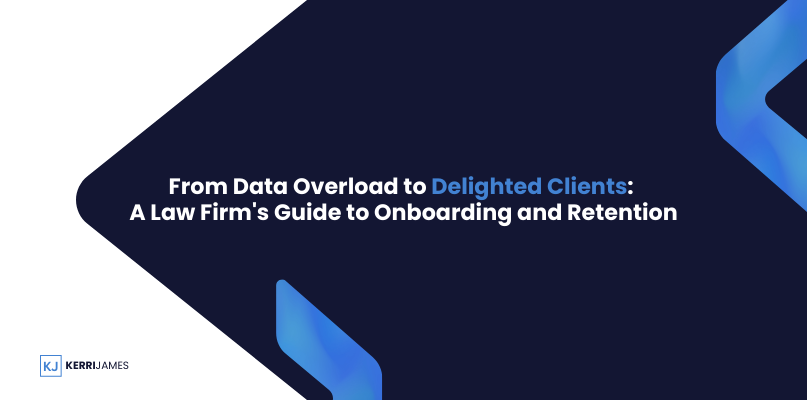“Data, data everywhere, but not a drop to drink.” This age-old lament resonates with a particular intensity in the hallowed halls of law firms across the globe. We’re drowning in data – client information, case details, billing records, court documents, communications – a never-ending torrent of raw, unstructured information that can feel more like a burden than a blessing. Transforming this overwhelming deluge into actionable insights can feel like an insurmountable challenge, a Sisyphean task with no end in sight.
This feeling of data overload rings especially true when it comes to the crucial, yet often elusive, arts of client onboarding and retention. These are the phases where the “human touch,” the warmth of personal connection, the trust built on empathy and understanding, have traditionally held sway. In a world increasingly dominated by data and technology, it’s tempting to cling to these human elements as if they’re fading relics of a bygone era, to view data as a cold, impersonal force, antithetical to the very essence of client relationships.
But what if I told you that this perceived dichotomy between data and human connection is a false choice? What if I told you that data, far from being a replacement for human intuition, can actually enhance those human connections, creating a powerful synergy that leads to happier, more engaged clients, a stronger brand reputation, and a healthier, more sustainable bottom line for your firm?
Because it absolutely can. It’s time to rewrite the narrative, to embrace the power of data not as a threat, but as your most valuable ally in the quest to deliver exceptional client experiences and build a thriving, future-proof law firm.
Let’s embark on a journey together, a deep dive into the transformative potential of data-driven strategies. We’ll explore how you can leverage data to revolutionize your client’s journey, transforming it from a potential pitfall riddled with uncertainty and missed opportunities into a resounding success story, one marked by trust, loyalty, and enduring value.
Stage 1: Deciphering the Data Landscape: Illuminating the Path to Client-Centric Insights
Every successful expedition begins with a clear understanding of the terrain. Before we can unlock the treasure trove of data-driven insights, we need to know what we’re working with, to identify the different types of data that, when woven together, create a rich tapestry of client understanding. In the context of client onboarding, retention, and overall client lifecycle management, think of data as falling into these key categories:
- Demographic Data: Painting the Portrait of Your Ideal Client, Stroke by Data Point: This foundational layer is all about understanding who your clients are, going beyond just their names, contact information, and case files. Age, location, profession, industry, areas of interest, hobbies, preferred communication styles, even their pain points and aspirations – these data points, seemingly disparate, come together to create a detailed, nuanced portrait of your client base. This granular understanding allows you to segment clients into meaningful groups, tailor your communications to resonate with their specific needs, and personalize your approach in a way that fosters genuine connection.
- Engagement Data: Tracking the Digital Footprints of Client Interaction: In today’s digital age, your firm’s website, online portals, and email communications are often the first point of contact for potential and existing clients. This category of data reveals how clients are interacting with your firm in this digital realm, providing invaluable insights into their level of interest, engagement, and potential needs. Website visits, page views, time spent on specific pages, email opens, link clicks, document downloads, form submissions, even social media interactions – these digital footprints paint a vivid picture of a client’s journey, allowing you to identify pain points, anticipate needs, and proactively engage in a way that feels personalized and responsive.
- Feedback Data: The Voice of Your Client, Amplified and Actionable: This invaluable data is where clients directly tell you what they think – satisfaction surveys, online reviews, testimonials, client feedback forms, even casual comments during phone calls or meetings. These are not just isolated data points, but a chorus of voices that, when listened to carefully, can provide a roadmap for continuous improvement. Embrace feedback, both positive and negative, as a gift – an opportunity to refine your processes, exceed expectations, and solidify client relationships built on trust and transparency.
- Case and Matter Data: Unearthing Patterns, Predicting Outcomes, Elevating Your Legal Strategy: This data delves into the heart of your legal work, capturing the intricate details of your cases and matters. Case types, jurisdictions, opposing counsel, judges assigned to cases, legal precedents cited, rulings and outcomes, even the language used in court documents – analyzing this data can reveal patterns, trends, and potential roadblocks that might otherwise remain hidden. This data-driven insight can transform your approach to case strategy, allowing you to refine your arguments, anticipate challenges, make more informed decisions about litigation strategy, and ultimately achieve better outcomes for your clients.
- Financial Data: Beyond the Billable Hour – Unveiling Profitability Insights and Strategic Growth Opportunities: Analyzing financial data, such as revenue per client, realization rates, profitability by practice area, the lifetime value of different client segments, and the cost-effectiveness of different marketing and business development initiatives, can reveal hidden opportunities to optimize your pricing models, refine your service offerings, and allocate resources more effectively. Data empowers you to move beyond the billable hour and develop innovative fee arrangements that align better with client needs, increase value perception, and ultimately enhance your firm’s financial sustainability.
Stage 2: Turning Data Into Actionable Intelligence: From Raw Insights to Transformative Impact
Collecting data is a necessary first step, but it’s merely the tip of the iceberg. The real magic – the true ROI of data-driven strategies – happens when we roll up our sleeves, put on our analytical thinking caps, and start digging into this wealth of information to uncover those “Aha!” moments, those golden nuggets of insight that can transform your practice. Here’s where things get truly exciting, where data transcends mere numbers and becomes a catalyst for meaningful change:
- Streamlining Onboarding: The Power of Personalization from Day One: Imagine this: A new client, a tech startup founder, walks through your door. Instead of handing them a generic welcome packet, you present them with a tailored folder, meticulously crafted based on their industry, their company stage, and their specific legal needs, identified through pre-intake data you gathered. The folder contains information on intellectual property protection, venture capital financing, and data security compliance – all areas relevant to their business. Another client, a family going through a divorce, receives a packet focused on child custody arrangements, spousal support, and division of assets, along with resources for emotional support and family mediation. This personalized touch, driven by demographic and engagement data, instantly makes clients feel seen, understood, and confident that they’ve chosen a firm that truly understands their unique challenges and goals.
- Predicting and Preventing Client Churn: Spotting the Warning Signs Before They Become Red Flags: Remember that “engagement data” we talked about? Now imagine this: You’re notified that a long-time client, a mid-sized business, has suddenly decreased their email open rates, hasn’t logged into the client portal in weeks, and hasn’t downloaded any documents recently. This deviation from their typical engagement patterns raises a red flag, a signal that perhaps something is amiss. Armed with this timely insight, you proactively reach out, initiating a conversation that uncovers a brewing concern about billing transparency. By addressing this concern head-on, providing clarity, and reassuring the client of your commitment to open communication, you not only retain a valuable client but strengthen the relationship, turning a potential crisis into an opportunity to deepen trust and loyalty.
- Turning Feedback into Action: Demonstrating that You’re Listening, You Care, and You’re Committed to Excellence: Let’s face it, receiving feedback, especially constructive criticism, can be tough to swallow. But it’s also an invaluable gift, a roadmap for growth and improvement. By analyzing client reviews, satisfaction surveys, and even those offhand comments during phone calls, you can identify patterns and pinpoint areas where your service delivery might be falling short. Are clients consistently frustrated with slow response times? Do they find the billing process opaque or confusing? Are they yearning for more frequent communication and case updates? Once you identify these pain points, you can take swift, decisive action to address them – whether it’s implementing new technologies to streamline communication, revising internal processes to improve efficiency, or providing additional training to your team to enhance client service skills. This commitment to continuous improvement, fueled by data-driven insights, speaks volumes to clients, demonstrating that you’re not content with the status quo, that you’re truly listening, and that their feedback is not just welcomed, but actively sought after and acted upon.
- Optimizing Case Strategy: Data as Your Secret Weapon in the Courtroom and Beyond: Gone are the days of relying solely on gut instinct and legal precedent to navigate the complexities of litigation. Case and matter data, when analyzed strategically, can be a powerful weapon in your legal arsenal. By studying past case outcomes, identifying patterns in judicial rulings, understanding the tendencies of opposing counsel, and even analyzing the language used in successful legal arguments, you can gain a significant edge. Data empowers you to develop more compelling arguments, anticipate your opponent’s next move, and make more informed decisions about settlement negotiations, trial strategy, and everything in between. This data-driven approach not only increases your chances of success in the courtroom but also enhances your reputation as a strategic thinker and a skilled advocate, someone who leaves no stone unturned in the pursuit of justice for their clients.
- Boosting Profitability: Unveiling Hidden Revenue Opportunities and Charting a Course for Sustainable Growth: Financial data analysis isn’t just for the accounting department – it’s a critical tool for strategic decision-making at all levels of your firm. By understanding your firm’s financial performance with laser-like precision – by practice area, client type, individual attorney, and even by specific service offerings – you can identify hidden pockets of profitability, as well as areas for improvement. Are certain practice areas consistently more profitable than others? Are there opportunities to implement alternative fee arrangements that align better with client budgets and increase value perception? By using data to drive financial decisions, you can optimize your pricing models, develop new service offerings that meet emerging client needs, improve resource allocation to ensure you’re investing in areas with the highest ROI, and ultimately enhance your firm’s overall profitability and long-term sustainability.
Stage 3: Building Your Data-Driven Law Firm: A Practical Roadmap for Lasting Success
Data-driven insights are incredibly powerful, but they don’t magically transform your firm overnight. It takes a commitment to change, a willingness to embrace new technologies and ways of thinking, and a dedication to weaving data into the very fabric of your firm’s culture and operations. But fear not, for this journey, while transformative, is not an insurmountable climb. Here’s a practical roadmap, a step-by-step guide to building a data-driven law firm that thrives in the digital age:
- Invest in the Right Tools: CRM software, practice management systems, and data analytics tools are essential for collecting, organizing, and interpreting your data.
- Establish Clear Processes: Make data collection systematic, not haphazard. Develop procedures for gathering client information, tracking engagement, and soliciting feedback.
- Prioritize Data Security: Client data is confidential. Robust cybersecurity measures are non-negotiable.
- Build a Culture of Data Literacy: Data isn’t just for one department – it’s everyone’s job! Provide training and resources to empower your team to use data insights in their daily work.
- Never Forget the Human Element: Data enhances your intuition, not replaces it. Use data to guide your decisions, but always lead with empathy and a focus on building strong client relationships.
Stage 4: Reaping the Rewards: The Tangible Benefits of Becoming Data-Driven, a Future of Growth, Sustainability, and Unparalleled Client Service
Embracing a data-driven approach is not just about keeping up with the latest legal tech trends – it’s about future-proofing your firm, ensuring its continued relevance, and positioning yourself as a leader in a rapidly evolving industry. The payoff for this commitment to data is significant and multifaceted, with tangible benefits that will resonate across all areas of your practice:
- Increased Client Acquisition: Personalized onboarding and targeted outreach, powered by data, attract the right clients to your firm.
- Improved Client Satisfaction: Data helps you anticipate needs, personalize service, and exceed expectations, fostering loyalty and positive word-of-mouth referrals.
- Reduced Client Churn: Proactively addressing concerns before they escalate, fueled by data insights, minimizes client churn and strengthens your reputation for client retention.
- Increased Revenue & Profitability: Satisfied, loyal clients are more likely to stick around and refer new business, leading to increased lifetime client value and a healthier bottom line.
The future of law is data-driven. By embracing data and using it strategically, you can build a more successful, client-centric firm that thrives in today’s competitive legal landscape.
The Future of Law Is Data-Driven: Embrace the Change, Shape Your Destiny, Lead With Confidence
In today’s increasingly competitive, rapidly evolving legal landscape, delivering exceptional client service is no longer a “nice-to-have” – it’s the bare minimum. To truly stand out from the crowd, to differentiate your firm, to attract top-tier clients, and to thrive in the years to come, you need to go above and beyond, to exceed expectations at every turn, and to deliver a client experience that is not just satisfactory, but truly exceptional. And that’s where data comes in – not as a cold, impersonal force, but as your secret weapon, your trusted advisor, and your guide to a future of growth, sustainability, and unparalleled client service.
Consider embracing data, not with fear or trepidation, but with excitement and a sense of possibility. By integrating this into your firm’s DNA, empowering your team to become fluent in the language of data-driven decision-making; you unlock unprecedented opportunities. Opportunities to deepen client relationships, to optimize your legal strategies, to drive internal efficiency, and to chart a course for sustainable growth that will not just weather the storms of change, but emerge stronger and more resilient than ever before.
The future of law is data-driven. The question is not if your firm will embrace this change, but when. Will you be a leader, a trailblazer, shaping the future of the legal profession? Or will you be left behind, struggling to catch up as your competitors race ahead?
The choice is yours. Choose wisely. Choose data.









